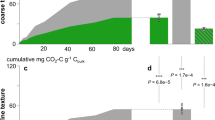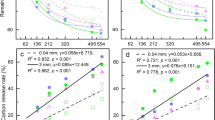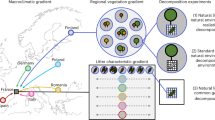Abstract
The carbon balance in terrestrial ecosystems is determined by the difference between inputs from primary production and the return of carbon to the atmosphere through decomposition of organic matter1. Our understanding of the factors that control carbon turnover in water-limited ecosystems is limited, however, as studies of litter decomposition have shown contradictory results and only a modest correlation with precipitation2,3,4,5. Here we evaluate the influence of solar radiation, soil biotic activity and soil resource availability on litter decomposition in the semi-arid Patagonian steppe using the results of manipulative experiments carried out under ambient conditions of rainfall and temperature. We show that intercepted solar radiation was the only factor that had a significant effect on the decomposition of organic matter, with attenuation of ultraviolet-B and total radiation causing a 33 and 60 per cent reduction in decomposition, respectively. We conclude that photodegradation is a dominant control on above-ground litter decomposition in this semi-arid ecosystem. Losses through photochemical mineralization may represent a short-circuit in the carbon cycle, with a substantial fraction of carbon fixed in plant biomass being lost directly to the atmosphere without cycling through soil organic matter pools. Furthermore, future changes in radiation interception due to decreased cloudiness, increased stratospheric ozone depletion, or reduced vegetative cover may have a more significant effect on the carbon balance in these water-limited ecosystems than changes in temperature or precipitation.
This is a preview of subscription content, access via your institution
Access options
Subscribe to this journal
Receive 51 print issues and online access
$199.00 per year
only $3.90 per issue
Buy this article
- Purchase on Springer Link
- Instant access to full article PDF
Prices may be subject to local taxes which are calculated during checkout


Similar content being viewed by others
References
Olson, J. S. Energy storage and the balance of producers and decomposers in ecological systems. Ecology 44, 322–331 (1963)
Montaña, C., Ezcurra, E., Carrillo, A. & Delhoume, J. P. The decomposition of litter in grasslands of northern Mexico: a comparison between arid and non-arid environments. J. Arid Environ. 14, 55–60 (1988)
Moorhead, D. L. & Reynolds, J. F. Mechanisms of surface litter mass loss in the northern Chihuahuan desert: a reinterpretation. J. Arid Environ. 16, 157–163 (1989)
Steinberger, Y., Shmida, A. & Whitford, W. G. Decomposition along a rainfall gradient in the Judean desert, Israel. Oecologia 82, 322–324 (1990)
Whitford, W. G. et al. Rainfall and decomposition in the Chihuahuan desert. Oecologia 68, 512–515 (1986)
Meentemeyer, V. Macroclimate and lignin control of litter decomposition rates. Ecology 59, 465–472 (1978)
Swift, M. J., Heal, O. W. & Anderson, J. M. Decomposition in Terrestrial Ecosystems (Univ. California Press, Berkeley, 1979)
Aber, J. D. & Melillo, J. M. Nitrogen immobilization in decaying hardwood leaf litter as a function of initial nitrogen and lignin content. Can. J. Bot. 60, 2263–2269 (1982)
Austin, A. T. Differential effects of precipitation on production and decomposition along a rainfall gradient in Hawai'i. Ecology 83, 328–338 (2002)
Gholz, H. L., Wedin, D. A., Smitherman, S. M., Harmon, M. E. & Parton, W. J. Long-term dynamics of pine and hardwood litter in contrasting environments: toward a global model of decomposition. Glob. Change Biol. 6, 751–765 (2000)
Vossbrinck, C. R., Coleman, D. C. & Wooley, T. A. Abiotic and biotic factors in litter decomposition in a semiarid grassland. Ecology 60, 265–271 (1979)
Schlesinger, W. H. & Lichter, J. Limited carbon storage in soil and litter of experimental forest plots under increased atmospheric CO2 . Nature 411, 466–469 (2001)
Nemani, R. R. et al. Climate-driven increases in global terrestrial net primary production from 1982 to 1999. Science 300, 1560–1563 (2003)
Kieber, D. J., McDaniel, J. & Mopper, K. Photochemical source of biological substrates in sea water: implications for carbon cycling. Nature 341, 637–639 (1989)
Miller, W. L. & Zepp, R. G. Photochemical production of dissolved inorganic carbon from terrestrial organic matter: significance to the oceanic organic carbon cycle. Geophys. Res. Lett. 22, 417–420 (1995)
Mopper, K. et al. Photochemical degradation of dissolved organic carbon and its impact on the oceanic carbon cycle. Nature 353, 60–62 (1991)
Tarr, M. A., Miller, W. L. & Zepp, R. G. Direct carbon monoxide production from plant matter. J. Geophys. Res. 100, 11403–11413 (1995)
Anesio, A. M., Tranvik, L. J. & Granéli, W. Production of inorganic carbon from aquatic macrophytes by solar radiation. Ecology 80, 1852–1859 (1999)
Schade, G. W., Hormann, R. M. & Crutzen, P. J. CO emissions from degrading plant matter. Tellus B 51, 899–908 (1999)
Johnson, D., Campbell, C. D., Lee, J. A. & Callaghan, T. V. Arctic microorganisms respond more to elevated UV-B radiation than CO2 . Nature 416, 82–83 (2002)
Pancotto, V. A., Sala, O. E., Robson, T. M., Caldwell, M. M. & Scopel, A. L. Direct and indirect effects of solar ultraviolet-B radiation on long-term decomposition. Glob. Change Biol. 11, 1982–1989 (2005)
Gehrke, C., Johanson, U., Callaghan, T. V., Chadwick, D. & Robinson, C. H. The impact of enhanced UV-B radiation on litter quality and decomposition processes in Vaccinum leaves from the subarctic. Oikos 72, 213–222 (1995)
Moody, S. A. et al. The direct effects of UV-B radiation on Betula pubescens litter decomposing at four European field sites. Plant Ecol. 154, 29–36 (2001)
Moorhead, D. L. & Callaghan, T. V. Effects of increasing UV-B radiation on decomposition and soil organic matter dynamics. A synthesis and modeling study. Biol. Fertil. Soils 18, 19–26 (1994)
Pancotto, V. A. et al. Solar UV-B decreases decomposition in herbaceous plant litter in Tierra del Fuego, Argentina: potential role of an altered decomposer community. Glob. Change Biol. 9, 1465–1474 (2003)
Sala, O. E., Golluscio, R. A., Lauenroth, W. K. & Soriano, A. Resource partitioning between shrubs and grasses in the Patagonian steppe. Oecologia 81, 501–505 (1989)
Yahdjian, L., Sala, O. E. & Austin, A. T. Differential controls of water input on litter decomposition and nitrogen dynamics in the Patagonian steppe. Ecosystems 9, 128–141 (2006)
Smith, S. D. et al. Elevated CO2 increases productivity and invasive species success in an arid ecosystem. Nature 408, 79–82 (2000)
Jackson, R. B., Banner, J. L., Jobbágy, E. G., Pockman, W. T. & Wall, D. H. Ecosystem carbon loss with woody plant invasion of grasslands. Nature 418, 623–626 (2002)
Thomas, D. S. G., Knight, M. & Wiggs, G. F. S. Remobilization of southern African desert dune systems by twenty-first century global warming. Nature 435, 1218–1220 (2005)
Acknowledgements
We acknowledge the late A. Soriano for establishment of a research program at the INTA study site more than 50 years ago; C. Mazza, L. Raiger, P. Flombaum, N. Sala, J. Vrsalovic, P. Araujo, L. Gherardi, M. Gonzalez-Polo, V. Marchesini, A. Fernández-Souto, P. Rojas, M. Taglizacchi and L. Yahdjian for field and laboratory assistance; and O. Sala, P. Vitousek, K. O'Shea, G. Piñeiro and C. Ballaré for comments on the manuscript. We acknowledge financial support from the Fundación Antorchas and the Fundación YPF of Argentina, the Inter-American Institute for Global Change Research, the US National Science Foundation, the Agencia Nacional de Promoción de Ciencia y Tecnología (ANPCyT) and the Universidad de Buenos Aires (UBACyT) of Argentina.
Author information
Authors and Affiliations
Corresponding author
Ethics declarations
Competing interests
Reprints and permissions information is available at npg.nature.com/reprintsandpermissions. The authors declare no competing financial interests.
Supplementary information
Supplementary Figures
This file contains Supplementary Figures 1–2 (PDF 11 kb)
Rights and permissions
About this article
Cite this article
Austin, A., Vivanco, L. Plant litter decomposition in a semi-arid ecosystem controlled by photodegradation. Nature 442, 555–558 (2006). https://doi.org/10.1038/nature05038
Received:
Accepted:
Issue Date:
DOI: https://doi.org/10.1038/nature05038
This article is cited by
-
Litter Decomposition Rates in a Post-mined Peatland: Determining Factors Studied in Litterbag Experiments
Environmental Processes (2024)
-
Microbiota and soil fauna mediate litter decomposition and associated carbon and nitrogen dynamics in mangrove blue carbon ecosystems: insights from a coastal lagoon in Malaysia
Hydrobiologia (2024)
-
Nutrient utilization strategies and age-related changes in Larix principis-rupprechtii forests
Plant and Soil (2024)
-
Visible light-exposed lignin facilitates cellulose solubilization by lytic polysaccharide monooxygenases
Nature Communications (2023)
-
Standing decomposition of dead leaves in winter and its legacy effects should not be ignored in subtropical forests
Plant and Soil (2023)
Comments
By submitting a comment you agree to abide by our Terms and Community Guidelines. If you find something abusive or that does not comply with our terms or guidelines please flag it as inappropriate.



